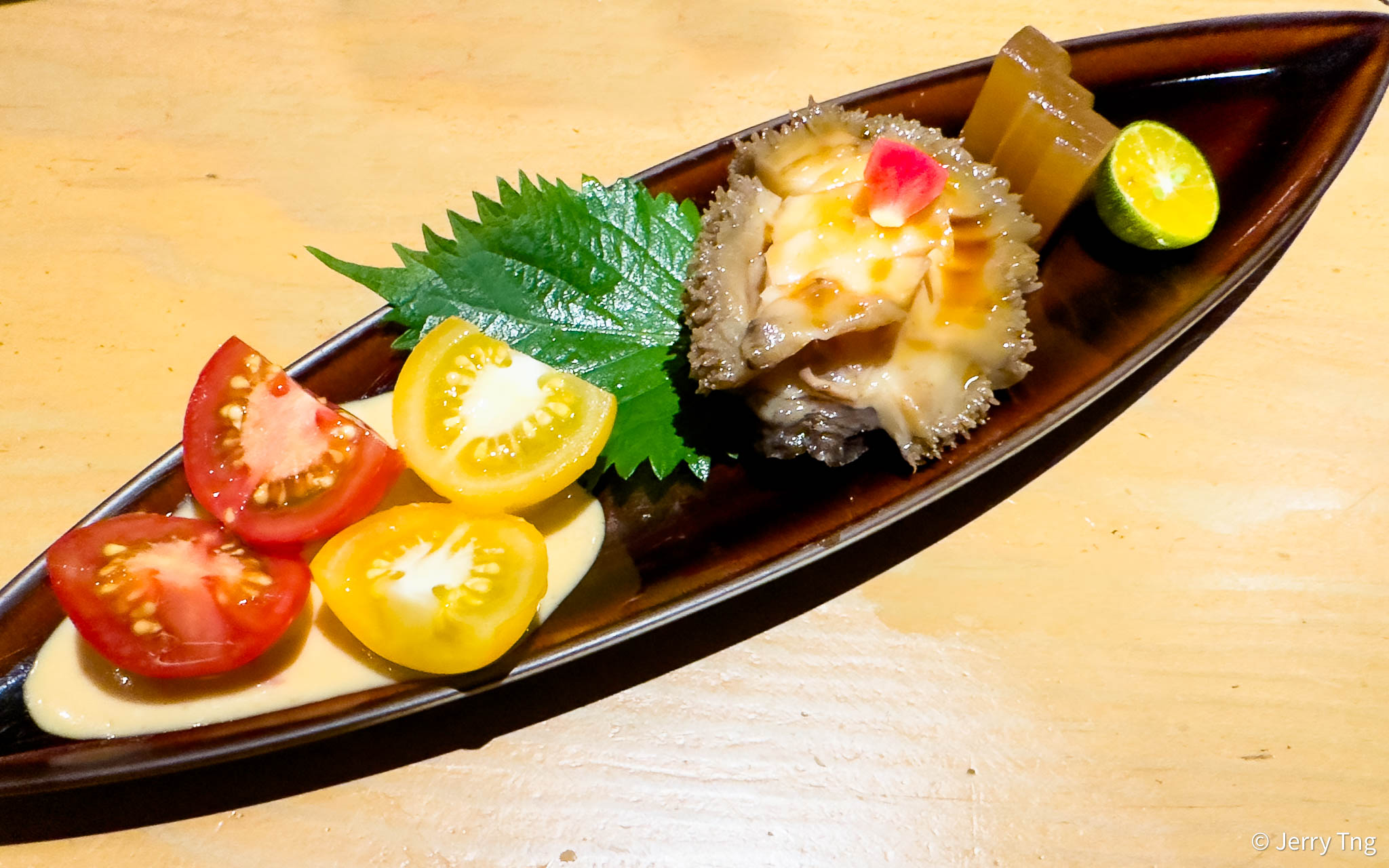Back in Taipei after all these years, first meal had to be Japanese.

Takumi is an omakase-only restaurant; there is no menu in an omakase. In addition to feeling the surprise of the food served on the table, the chef’s various ideas of cooking with the freshest ingredients is actually the key to make the experience more exciting.

Owner and Chef Hong heads the itamae and was quick to share the origin and concept behind each dish. He started as a sushi apprentice in Taipei and then went over to Japan to perfect his skill.
The Omakase Dinner

The first appetiser was a salad made with bamboo shoots, shredded king crab, caviar and 赤紫蘇梅酢 red shisho plum vinegar. We were told to mix everything up before eating.

The salad was refreshing and the bamboo shot had a natural sweetness. The vinegar drowned out the king crab though.

The next appetiser consisted of some heirloom cherry tomatoes with Kewpie mayo, and a cold served braised abalone with a spicy sauce. The abalone was chewy and quite tasteless.

I was surprised by the condiments that came on the plate. Red onions? That’s the first time I have seen this served with sushi or sashimi. And it came with an assortment of pickles that would only be found with rice in a washoku. Interesting and weird.



The fresh ingredients were on parade along the chillers on the counter. And strangely there’s a live tank of lobsters on the counter too. The movement of the itamae chef to the customers was quite restricted by these installations.

Madai 真鲷 Japanese sea bream from Kagoshima is white and transparent with a light amber colour. The soft and firm meat is of the most delicious taste. The fish was served using the kawashimozukuri 皮霜造り method of splashing the skin with boiling water to tenderize it, then quickly chilling it with ice to maintain the crunch. The lime zest sprinkled by the chef has a bonus effect on the fragrance of the mackerel, and the light rose salt was a subtle touch.

北海道厚岸牡蠣 Hokkaido Akeshi oysters are available all year round, thanks to the excellent waters along the coastline of Hokkaido. They have good liquor and thick flesh, a good oyster to be eaten shucked. However the preparation did not do justice to the oyster. It wasn’t that large that you had to cut it into two. Also it was over-washed and lost all the liquor.

With fruit vinegar and spicy mashed radish, it is a rare condiment on a piece of sashimi. The 真羽太 seven band grouper from Hokkaido was firm and had a good bite. The taste was very clean, and hence required the condiments to give it more dimension.

縞鯵 Shima-aji (Japanese striped jack) signifies summertime, with its shun period from June to August. When aged for a few days, the firm, fatty flesh develops an even better flavour profile that is just delightful, especially when paired with good sushi-meshi (鮨飯) Without too much seasoning, you can taste the sweetness and deliciousness of the fish itself.

The fine knife works made the 雲丹 sea urchin and イカ squid more integrated. As you chewed, the squid was completely surrounded by sea urchin, combining the sweetness and crunch of the squid with the umami and ratification that only sea urchin can provide. The complex and rich taste faintly exuded the special aroma of シソ perilla leaves.

This cut of 中トロ tuna belly was selected between the middle abdomen and the large abdomen that came with less veins. The aburi treatment released the oil in the tuna and gave it a smoky taste. The tuna was slightly marinated like zuke, so there’s no need to dip it in soy sauce.

Botan-ebi 牡丹蝦 ボタンエビ has a more potent sweetness and luxurious flavour than Amaebi shrimp. The botan shrimp was topped with shrimp paste made from the head of the prawn, and then torched on the surface. It was then finished with a scratch of rose rock salt for a bit of savouriness.

縁側 Engawa from Kyushu is the meat from the tail fin muscles of hirame (flounder) – a flatfish that dwells on the ocean floor. Each flounder has only 4 tail fins, making engawa highly valued – 2 kg fish can produce just 14 engawa nigiri. On top of that, it is packed with rich fatty flavours and a slightly chewy texture, it simply melted like butter as you bite into it.

Nodoguro ノドグロ Blackthroat sea perch is a special fish, so called because of the black throat. It is delicious when grilled because of its fatty flesh. I really didn’t like the salt and five spice provided, so I just ate it as is. I wished the skin could be crispier.

The next cooked course was a steamed rock lobster that was still swimming in the tank a while ago. The lobster was firm and sweet with a lot of head miso.

The miso soup was made with fish stock and was quite delicious.

At this point in ttime, I was still unsatisfied from the courses from the omakase. I expected some kind of maki to round up the meal. This was an ala carte order of tekka maki (tuna roll) made with chutoro (medium fatty belly). I hade to say that it was really delicious despite the additional cost.

The dessert was a big disappointment. Cut fruits and ice cream just couldn’t cut it.

There were too many pieces of aburi sushi, which is the craze in Taipei right now but I didn’t expect to pay so much for the fish to adulterated. Overall the techniques were not polished despite the high score in Google. Don’t recommend to come back.
Takumi Sushi 匠すし
No. 68, Section 1, Jianguo N Rd, Zhongshan District, Taipei City, Taiwan 10491
建國北路一段68號, 中山區, 台北市
Tel : +886 (0)2 2508 0904
Visited Sep 2023

0 comments on “Takumi Sushi 匠すし @ Taipei”